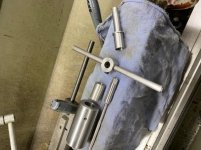I’m trying to get a better understanding of how to setup and use a throating reamer. Here’s a few basic questions I have….
1). I’ve looked at PTG, JGS, and Manson. From just looking at their catalogs, it looks like the PTG is piloted but not the others. Are there any other manufacturers offering piloted throaters?
2). I have seen these for sale with a T handle but if chambering through headstock and bore is still indicated, is this a better procedure to be done on the lathe?
3). If done on a lathe, would a floating reamer holder be suitable for this? Im picturing this setup being guided with the pilot but no lateral support like a chamber reamer would have. Would this cause uneven cutting?
4). Depth of cut and touch off. Im thinking that a magnetic base indicator would be ok to show depth of cut, just go slow and measure often, but I’m assuming you wouldn’t be able to feel any touch off unless machine was off.
Thanks for any help and guidance on this.
1). I’ve looked at PTG, JGS, and Manson. From just looking at their catalogs, it looks like the PTG is piloted but not the others. Are there any other manufacturers offering piloted throaters?
2). I have seen these for sale with a T handle but if chambering through headstock and bore is still indicated, is this a better procedure to be done on the lathe?
3). If done on a lathe, would a floating reamer holder be suitable for this? Im picturing this setup being guided with the pilot but no lateral support like a chamber reamer would have. Would this cause uneven cutting?
4). Depth of cut and touch off. Im thinking that a magnetic base indicator would be ok to show depth of cut, just go slow and measure often, but I’m assuming you wouldn’t be able to feel any touch off unless machine was off.
Thanks for any help and guidance on this.






